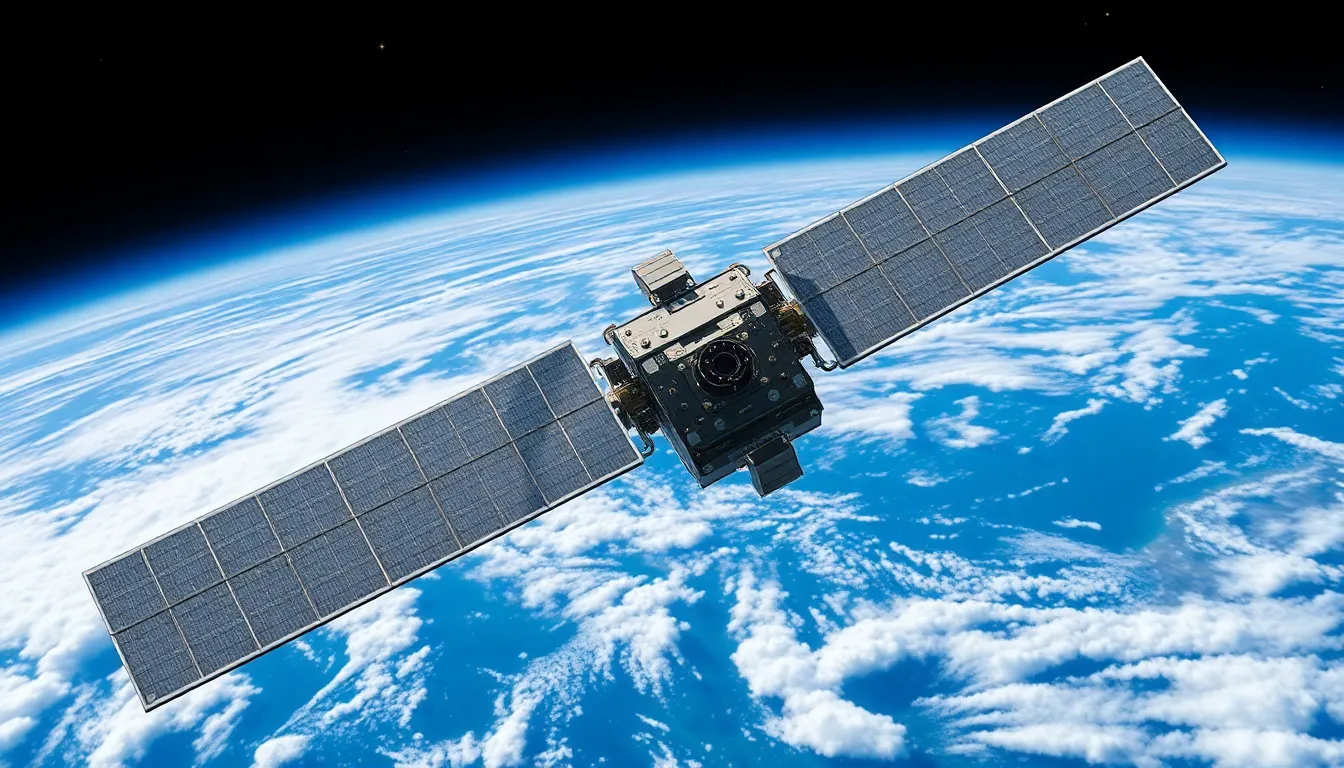Ever wondered how meteorologists predict whether you’ll need an umbrella or sunscreen? The answer lies in the marvels of space technology. Satellites orbiting high above Earth are the unsung heroes of weather forecasts, climate studies, and environmental monitoring. They gather data that keeps us informed and, let’s be honest, sometimes keeps us from getting drenched on a picnic day.
From advanced sensors to high-resolution imaging, these space gadgets are like the ultimate weather spies. They don’t just watch the skies; they analyze storms, track climate change, and even monitor pollution levels. So next time you check the weather app, remember that a whole fleet of sophisticated technology is working tirelessly to keep you one step ahead of Mother Nature’s surprises.
Table of Contents
ToggleOverview of Space-Based Data Collection
Satellites serve as vital instruments for gathering data related to weather, climate, and environmental monitoring. They utilize various technologies to capture critical information from space. Sensors equipped on these satellites measure temperature, humidity, and atmospheric pressure, facilitating real-time assessments of weather patterns.
Imaging capabilities play a significant role in monitoring natural events. For example, advanced imaging allows for tracking hurricanes, tornadoes, and typhoons, providing early warnings to communities at risk. The integration of radar systems enhances the accuracy of precipitation data, improving forecasting models.
Climate monitoring benefits from satellite missions that observe long-term trends. Instruments onboard collect data on global temperatures, sea level rise, and greenhouse gas concentrations. These metrics are crucial for understanding climate change’s impacts on ecosystems and human activities.
Moreover, remote sensing technologies enable the detection of pollution levels and deforestation rates. Satellites equipped with multispectral and hyperspectral sensors analyze vegetation health, offering insights into agricultural practices. They assist in tracking land-use changes that affect biodiversity and natural resources.
Existing satellite networks, such as the National Oceanic and Atmospheric Administration and NASA, continually relay valuable data to researchers. Data collected from these sources enhances scientific knowledge and informs policy decisions. Partnerships among space agencies foster collaborative efforts in data sharing and analysis, leading to improved environmental management strategies.
Space-based data collection remains essential for comprehending and responding to the dynamic nature of Earth’s systems.
Key Technologies for Weather Monitoring

Satellites play a vital role in collecting data for weather, climate, and environmental monitoring. These technologies provide invaluable insights that inform public safety and policy decisions.
Satellite Imagery
Satellite imagery captures detailed visuals of the Earth’s surface, enabling real-time observations. High-resolution images show cloud patterns, storm developments, and land usage changes. This capability allows meteorologists to track severe weather systems like hurricanes and thunderstorms. Deployment of multispectral sensors adds dimensionality, providing data in various wavelengths to analyze vegetation health and surface temperatures. Crucially, periodic imaging helps researchers identify trends in environmental shifts, such as urban expansion and deforestation.
Remote Sensing
Remote sensing technologies utilize different types of sensor data to monitor atmospheric conditions. Instruments aboard satellites measure temperature, humidity, and winds from space, offering comprehensive climate assessments. Active sensors emit signals and analyze their reflections to detect rainfall and other weather phenomena. Passive sensors capture natural thermal radiation from the Earth’s surface, helping monitor heat trends. Continuous data collection from these sensors aids scientists in understanding climate change’s long-term effects and implementing effective mitigation strategies.
Advances in Climate Monitoring Technologies
Satellites play a pivotal role in enhancing climate monitoring technologies. They provide critical data essential for understanding atmospheric phenomena and long-term climate patterns.
Climate Satellites
Climate satellites monitor Earth’s changing environment and collect data on temperature, humidity, and greenhouse gas concentrations. NASA’s Aura satellite focuses on air quality by measuring pollutants like ozone and carbon dioxide. The European Space Agency’s Sentinel satellites contribute to monitoring deforestation, agriculture, and land use changes. Together, these satellites utilize advanced instruments to capture Earth’s surface imagery and atmospheric data. High-resolution photos reveal cloud movements and storm formations, enabling timely forecasts and risk assessments. Satellite data informs climate models, improving predictions about climate variability and extreme weather events. Accurate and reliable observations are crucial for understanding the impact of human activities on global ecosystems.
Data Assimilation Techniques
Data assimilation techniques integrate satellite observations with ground-based measurements to enhance climate models. These methods, including Four-dimensional variational assimilation (4D-Var), refine predictions by adjusting models according to real-time data. By combining diverse data sources, scientists improve the accuracy of weather forecasts and climate projections. Techniques such as ensemble Kalman filtering also contribute to optimizing data usage, allowing for predictive analysis of atmospheric conditions. Employing these techniques reveals trends in precipitation patterns and temperature fluctuations, helping address challenges like droughts and floods. Efficient data assimilation enhances the scientific understanding of climate systems and supports informed policymaking to combat climate change.
Environmental Monitoring from Space
Satellites play a crucial role in environmental monitoring, collecting and relaying data to assess global changes. These technologies provide insights vital for understanding climate patterns and ecological shifts.
Earth Observation Satellites
Earth observation satellites monitor various environmental parameters from space. They track land use changes, deforestation, and urban development. Notable examples include NASA’s Landsat and the European Space Agency’s Copernicus program. These satellites capture high-resolution images, offering essential data for scientists and policymakers. They contribute to understanding phenomena like ice melt and sea level rise. Overall, continuous monitoring enhances climate modeling and promotes sustainable practices.
Sensor Technologies
Sensor technologies on satellites collect diverse data types critical for weather and climate analysis. Passive sensors detect reflected sunlight, measuring surface temperatures and vegetation health. Active sensors provide information on atmospheric conditions by emitting signals that analyze rainfall and humidity levels. Specific multispectral and hyperspectral sensors capture data across various wavelengths, allowing for detailed analyses of environmental changes. These sensors contribute significantly to tracking greenhouse gas emissions and air quality, thus informing regulatory policies and environmental management.
Future Trends in Space-Based Monitoring
Innovations in satellite technology are shaping the future of weather, climate, and environmental monitoring. Enhanced sensor capabilities are crucial for collecting precise data on atmospheric conditions. For instance, the deployment of hyperspectral sensors will improve the detection of chemical pollutants in the air.
Machine learning techniques will soon analyze satellite data more effectively, identifying patterns in climate variability. Such advancements could lead to more reliable climate predictions, assisting scientists and policymakers in making informed decisions.
Collaboration among international space agencies is expected to expand. By sharing data and resources, they can create comprehensive global monitoring systems. The European Space Agency’s Copernicus program exemplifies this, offering critical insights into land use changes and ecological health.
Moreover, small satellite constellations are emerging as a cost-effective solution for continuous monitoring. These networks enable real-time data collection, providing updated information on severe weather events and natural disasters. Drones may complement satellite data by capturing localized environmental changes that satellites may miss.
Emerging technologies like quantum sensing could revolutionize data accuracy in environmental monitoring. Future satellites may incorporate these techniques for enhanced measurements of greenhouse gases and particulate matter in the atmosphere.
The integration of satellite observations with Internet of Things (IoT) devices represents another trend. This combination can offer detailed insights into urban heat islands and water quality in real time. As these technologies evolve, they will play a vital role in addressing climate change challenges and fostering sustainable practices.
The advancements in satellite technology have revolutionized the way data is collected for weather, climate, and environmental monitoring. With sophisticated sensors and imaging capabilities, these satellites provide invaluable insights into atmospheric conditions and long-term climate trends. The integration of data from various sources enhances the accuracy of weather forecasts and climate models, enabling better preparedness for natural disasters.
As technology continues to evolve, the future of space-based monitoring looks promising. Innovations like hyperspectral sensors and machine learning will further refine data collection and analysis. Collaborative efforts among international space agencies will ensure a comprehensive approach to understanding and addressing environmental challenges, making space-based monitoring an indispensable tool for sustainable practices and informed policymaking.





